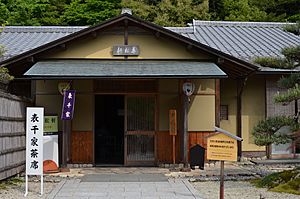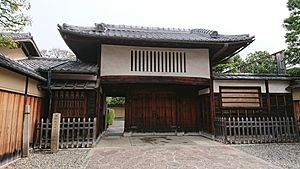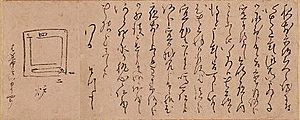Omotesenke facts for kids
Omotesenke (表千家) is one of the main schools of Japanese tea ceremony. It is one of the three important families that teach the tea ceremony. These families are all related to Sen no Rikyū, a very famous tea master. The other two families are Urasenke and Mushakōjisenke. Together, they are known as the "three Sen houses" (san-Senke).
The name "Omotesenke" means "front Sen house." This name came about because of where their family home was located. It was at the front of the original Sen family estate. The "Urasenke" family home was at the back (ura) of the estate. The "Mushakōjisenke" family lives on Mushakōji street, which is how they got their name.
Contents
History of Omotesenke
The Omotesenke family home is called the "Fushin-an" (不審庵). This is the name of its special tea room. After Sen no Rikyū died, his son-in-law, Sen Shōan, brought the Sen family back together in Kyoto. This happened at the Fushin-an estate. It is located on Ogawa street in the Kamigyō ward of Kyoto.
Shōan's son, Sen Sōtan, later became the head of the family and the estate. Sōtan's third son, Kōshin Sōsa, took over as the fourth leader of the Omotesenke family. When Sōtan decided to retire, he built a small tea room next door. This tea room was called the "Konnichi-an" (今日庵). Later, Sōtan's youngest son, Sensō Sōshitsu, inherited this part of the estate. This became the home of the Urasenke school.

Omotesenke Tea Style
Each tea school has its own small differences in how they perform the tea ceremony. For example, the Omotesenke school whisks the tea less than the Urasenke school. This means there is less foam on top of the tea.
Also, Omotesenke uses two types of bamboo whisks called chasen. They use a natural bamboo whisk and a susudake chasen, which is a darkened bamboo whisk. The Urasenke school, however, only uses natural, untreated bamboo for their chasen.
The Fushin-an estate is still the main home and office for Omotesenke. It is where the third generation leader, Sōtan, lived before he retired. The Kitayama Kaikan in Kyoto is a newer Omotesenke building. Here, Omotesenke holds exhibitions, talks, and educational programs for everyone.
Learning the Tea Ceremony
Students learning the tea ceremony receive special permissions called kyojō (許状), menjō (免状), or sōden (相伝). These permissions allow students to learn different tea procedures.
Students start with basic lessons and then move on to more complex ones.
Basic Skills: Warigeiko
The very first skills a student learns are called warigeiko. This means "divided training." These are basic skills you practice separately before you start making tea. They are the building blocks for all tea procedures (temae).
Here are some of the basic skills you learn:
- Tea room manners: How to open and close sliding doors, how to walk in the tea room, where to sit, and when to bow. You also learn basic guest behavior, like how to use a fan.
- Fukusa: This is a special cloth. You learn how to fold, open, and handle it correctly.
- Natsume: This is a type of tea container. You learn how to fill it with tea, pick it up, hold it, and clean it.
- Chashaku: This is the tea scoop. You learn how to hold and clean it.
- Hishaku: This is the ladle. You learn how to handle it and special ways to use it for hot and cold water.
- Chasen: This is the tea whisk. You learn how to hold it and how to whisk the tea properly.
- Chakin: This is the tea cloth. You learn how to fold it and use it to clean the tea bowl.
- Chawan: This is the tea bowl. You learn how to handle it both as the host and as a guest.
Headmasters of Omotesenke
The leader of the Omotesenke family is called the iemoto. Their family name is always Sōsa.
| Generation | Personal Name | Japanese Name | Buddhist Name | Japanese Buddhist Name |
|---|---|---|---|---|
| 1st | Rikyu Sōeki (1522-1591) | 利休 宗易 | Hōsensai | 抛筌斎 |
| 2nd | Shōan Sōjun (1546-1614) | 少庵 宗淳 | ||
| 3rd | Genpaku Sōtan (1578-1658) | 元伯 宗旦 | Totsutotsusai | 咄々斎 |
| 4th | Kōshin Sōsa (1613-1672) | 江岑 宗左 | Hōgensai | 逢源斎 |
| 5th | Ryōkyū Sōsa (1650-1691) | 良休 宗佐 | Zuiryūsai | 随流斎 |
| 6th | Gensō Sōsa (1678-1730) | 原叟 宗左 | Kakkakusai | 覚々斎 |
| 7th | Ten'nen Sōsa (1705-1751) | 天然 宗左 | Joshinsai | 如心斎 |
| 8th | Ken'ō Sōsa (1744-1808) | 件翁 宗左 | Sottakusai | 啐啄斎 |
| 9th | Kōshuku Sōsa (1775-1825) | 曠叔 宗左 | Ryōryōsai | 了々斎 |
| 10th | Shōō Sōsa (1818-1860) | 祥翁 宗左 | Kyūkōsai | 吸江斎 |
| 11th | Zuiō Sōsa (1837-1910) | 瑞翁 宗左 | Rokurokusai | 碌々斎 |
| 12th | Keiō Sōsa (1863-1937) | 敬翁 宗左 | Seisai | 惺斎 |
| 13th | Mujin Sōsa (1901-1979) | 無盡 宗左 | Sokuchūsai | 即中斎 |
| 14th | Sōsa (1938-) | 宗左 | Jimyōsai | 而妙斎 |
| 15th | Sōsa (1970-) | 宗左 | Yūyūsai (current iemoto) | 猶有斎 |



